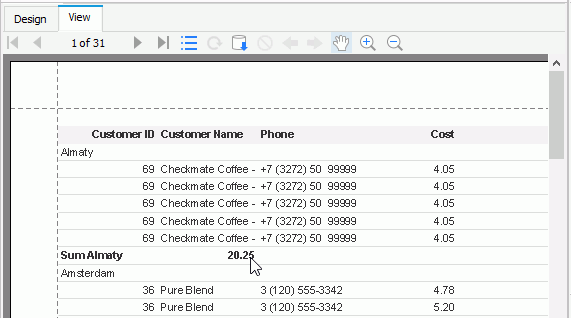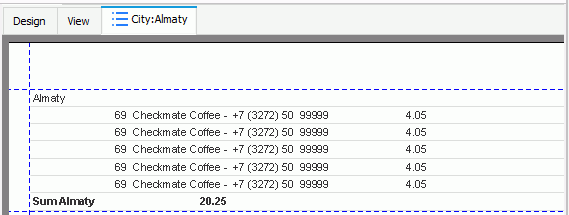 Previous Page Next Page
Previous Page Next Page
In the process of designing a page report, you can preview the report tabs in it at any time in JReport format or other formats.
When previewing a page report tab,
To preview a report tab in JReport format, just click the View tab, which then causes the JReport Engine to run the report tab. The result is then shown in the viewer. To optimize performance, JReport Designer displays report pages before they have been completely generated. For details about the options in the View tab, see Design/View area.
In addition, when previewing a banded object, you are able to dynamically sort the records and show details of aggregate level fields.
Dynamic sort
You can sort the records in a banded object dynamically in the View area. To do this, point to the field you want to sort, then right-click the field and select the option Sort Ascending or Sort Descending from the shortcut menu.
Showing aggregation detail
You can show details of aggregate level fields in a banded object. Showing detail is made possible where there is a summary for a group. For example, if a banded object has been grouped by City, and the group summary is on Cost. When previewing the banded object, if you point the mouse at the total cost sales for a city, it will turn into a small hand. Click on the total, and the detail report for the selected city will be displayed.


By default, in cases like the above, JReport's convention is to hide the detail panel of each group and only show it in a detail report. To do this, select the detail panel, go to the Report Inspector and set its Invisible property to true (make sure the Suppress property is false). Then view the banded object again, and it will be shown without details. If you want to see the details of a certain city, point the mouse at the city's total annual sales, when the mouse turns into a small hand, click on the total, and the detail report for the city will be displayed.


Note: After some modifications in the design area, if you find the report tab is shown very quickly and the changes are not applied in view mode, this means you need to click the Refresh Data button  on the toolbar to re-run your report tab.
on the toolbar to re-run your report tab.
JReport also allows you to preview your report tab in the following formats: Page Report Result, HTML, PDF, Excel, Text, RTF, XML and PostScript. To do this, click View > Preview As and the select a format from the drop-down menu. If Page Report Result is selected, the report tab will be opened in Page Report Studio. When any of the other formats is selected, the report tab will be exported to a temporary file which will automatically be opened in the format with the appropriate application. The temporary file will be removed when you exit JReport Designer. If you want the file to be saved so that you can review it at any time, use the Export feature instead.
Notes:
-Djreport.url.encoding=UTF-8 in the startup batch file and this setting covers URL encoding/decoding. Therefore, when you preview a report tab in Page Report Result format, if the name of the report tab or its report or catalog file contains non-Latin characters, you need add -Djreport.url.encoding=UTF-8 into the startup batch file of JReport Designer as well; otherwise the preview will fail. <install_root>\server\bin.<install_root>\server\lib directory, modify the udo.ini file in <install_root>\server\lib and append the classes to the class path of JRServer.bat in <install_root>\server\bin (make sure that the path of the file JREngine.jar is before that of the file report.jar). For details, see Creating a UDO Manually.<install_root>\server\bin.